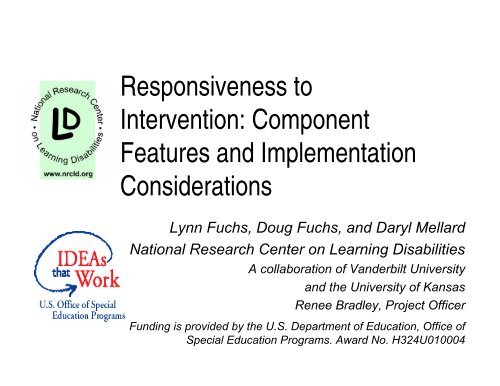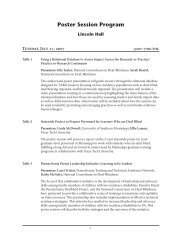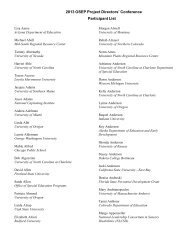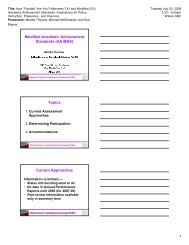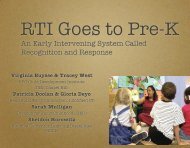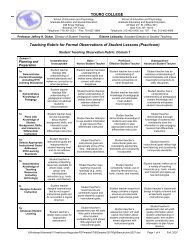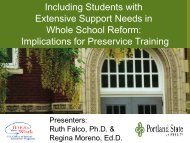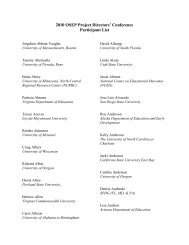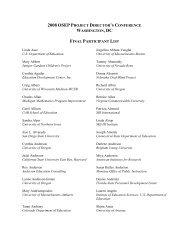RTI presentation - OSEP Project Directors' Conference
RTI presentation - OSEP Project Directors' Conference
RTI presentation - OSEP Project Directors' Conference
- No tags were found...
You also want an ePaper? Increase the reach of your titles
YUMPU automatically turns print PDFs into web optimized ePapers that Google loves.
Responsiveness toIntervention: ComponentFeatures and ImplementationConsiderationsLynn Fuchs, Doug Fuchs, and Daryl MellardNational Research Center on Learning DisabilitiesA collaboration of Vanderbilt Universityand the University of KansasRenee Bradley, <strong>Project</strong> OfficerFunding is provided by the U.S. Department of Education, Office ofSpecial Education Programs. Award No. H324U010004
<strong>Project</strong> Staff• Vanderbilt University• Doug Fuchs, Co-Director & PrincipalInvestigator• Dan Reschly, Co-Director & PrincipalInvestigator• Lynn Fuchs, PrincipalInvestigator• Don Compton, PrincipalInvestigator• Joan Bryant, <strong>Project</strong>Coordinator• University of Kansas• Don Deshler, Co-Director & PrincipalInvestigator• Daryl Mellard, PrincipalInvestigator• Sonja de Boer-Ott,<strong>Project</strong> Coordinator• Julie Tollefson,DisseminationCoordinator• Melinda McKnight,Research Assistant• Barb Starrett, ResearchAssistant
Regional Resource Centers• Federal Resource Center• Rex Shipp• Region 1: Northeast• Kristin Reedy, Director• Rich Reid, Representative• Region 2: Mid-South• Ken Olsen, Director• Kathy Chapman,Representative• Nancy Sander,Representative• Region 3: Southeast• Elizabeth Beal, Director• Larry Martin,Representative• Region 4: North Central• Michael Sharpe, Director• Tom Delaney,Representative• Region 5: Mountain Plains• John Copenhaver, Director• Carol Massanari, Codirector/Representative• Geralynn Olvey,Representative• Region 6: Western• Caroline Moore, Director• Brad Lenhardt,Representative
NRCLD Mission• The National Research Center on LearningDisabilities• conducts research on the identification oflearning disabilities• formulates implementation recommendations• disseminates findings• provides technical assistance to national, state,and local constituencies
Purposes of the NRCLD• To understand how alternative approachesto identification affect who is identified.• To investigate state and local identificationpolicies and practices and LD prevalence.• To provide technical assistance and conductdissemination to enhance state and localpractice in identification.• To identify sites that effectively useresponsiveness-to-intervention as a methodof identification.
Goal 1: Enhanceunderstanding of LD andhow alternativeapproaches to LDidentification affect whogets identified(Vanderbilt)
Goal 4: Assist the RRCs indesigning, implementing,and analyzing results of anevaluation ofresponsiveness-tointervention(<strong>RTI</strong>) programsin local schools in six RRCregions(KU)
Statutory language (IDEA, 2004)The language of IDEA 2004 does not specifically usethe term “responsiveness to intervention (<strong>RTI</strong>).”The statute states: “In determining whether a child hasa specific learning disability, a local educationalagency may use a process that determines if thechild responds to scientific, research-basedintervention as a part of the evaluation procedures. ..” (IDEA 2004, Sec. 614 (b) (6) (B)).In the special education research literature, the processis generally considered as referring to <strong>RTI</strong>.<strong>RTI</strong> is not mandated (e.g., “. . . a local agency may use aprocess. . .”).
What do we mean by <strong>RTI</strong>?1. <strong>RTI</strong> has two goals: prevent academic problemsand determine students with LD.2. 2 or more tiers of increasingly intenseinterventions.3. Varied duration, frequency, time of interventions,P/T ratio, and teacher skill4. Use a problem solving model or standardizedtreatment protocol for intervention tiers.5. Implementation of a differentiated curriculum withdifferent instructional methods.6. Explicit decision rules for judging learners’progress.
What does <strong>RTI</strong>implementation look like?1. Students receive high quality, research-basedinstruction by qualified staff in their general educationsetting.2. General education instructors and staff assume anactive role in students’ assessment in that curriculum.3. School staff conduct universal screening of(a) academics and (b) behavior.4. School staff implement specific, research-basedinterventions to address the student’s difficulties.
Other features of <strong>RTI</strong>5. Continuous progress monitoring of studentperformance occurs (weekly or biweekly).6. School staff use progress-monitoring dataand decision rules to determine interventions’effectiveness and needed modifications.7. Systematic assessment of the fidelity orintegrity with which instruction andinterventions are implemented.
Standard Treatment Protocol ApproachTo Responsive-to-Intervention• The standard treatment is for the student toreceive a validated, intense intervention• The bad news is that all students receive thesame intervention• The good news is that the interventions are wellspecified,sequenced with clear outcomes• The interventions are more likely to be deliveredwith fidelity; training is consistent• Increases the consistency of services; easy tocheck for implementation
Advantages of Response-to-Intervention Approach1. Provides assistance to needy children intimely fashion.2. Helps ensure that the student’s pooracademic performance is not due to poorinstruction.3. Assessment data are collected to inform theteacher and improve instruction.4. Assessments and interventions are closelylinked.
Goal 4: GoalsPhase 11. Determine whether/how an <strong>RTI</strong> model isbeing implemented2. Clarify whether/how an <strong>RTI</strong> model is usedto determine LD eligibilityPhase 23. Establish whether/how an <strong>RTI</strong> model is aneffective prevention system4. Validate whether/how an <strong>RTI</strong> modelenhances LD identification
Phase I: <strong>RTI</strong> Model SiteApplications• Reviewed 41 applications• Blind reviews• Review panel of six NRCLD staff• Minimum of two reviews for applications notmeeting the selection criteria• 19 evaluation items (6 items/tier); % possible• Items scored: 0, .5, 1, 1.5, and 2• 0 = no information• 2 = fully specified, descriptive
Phase 1 Sample Items• School uses multiple tiers• The building level administrator isinvolved in instruction fidelity checks,and <strong>RTI</strong> implementation• The schools have a designated cutscore to distinguish “responsiveness”and “unresponsiveness.”
Phase I: Two Selection Rules1. Score of > 1.5: <strong>RTI</strong> is used in LDidentification• Grade levels implemented• Additional assessments?• Due process procedures• On what information is LD determinationmade?2. Total points: > 80% by two judges
Phase 1 Nominations# ofTiersItems/Max.pts# ofApps%213/261127%319/381844%425/501024%531/6225%41100%
Hybrid <strong>RTI</strong> Total %Categorical 1 1 2 33%Noncategorical0 4 4 67%Total 1 5 6 100%% 17% 83% 100%A Closer Look at the 5 SitesService DeliveryLD DeterminationHybrid<strong>RTI</strong>TotalCategorical202Noncategorical033Total235
Phase 2 review 1. Parent and school staffa) Activity involvementb) Time engagement2. <strong>RTI</strong> implementationa) Fidelity checks3. Prevention evidencea) Reading scoreb) Referral patterns4. LD determinationa) Demographic markersb) LD vs. non-SPED char5. LD enhancementa) Instructional differencesb) Exit criteria
Implementation considerations1. RRC staff reportingpositive climates ofthe schools; yet low %implementation2. High frequency:• Use S, EB in Tier 2• Progress monitoring(DIBELS; CBM)• Dbase for instrdecisions1. Theory of practice:For schools, the issueis about gettingservices to students,not disabilitydetermination2. Research examplesmarkedly differentthan school examplese.g. interventionspecification, fidelitychecks, cutpoints,decision-making rules
Frequently Asked Questions• Will this process delay identification?• Does each child have to go through<strong>RTI</strong> or can a child have a traditionalassessment?• What will be required for professionaldevelopment?• Who is responsibility for the variousactivities required to implement <strong>RTI</strong> asa method of LD identification?
Frequently Asked Questions(continued)• What proportion of students is likely to beidentified as at risk (for Tier 1 monitoring)and for the Tier 2 diagnostic trial?• Are schools currently implementing <strong>RTI</strong> asa method of LD identification and, if so,how can I find learn more about theirmethods?


